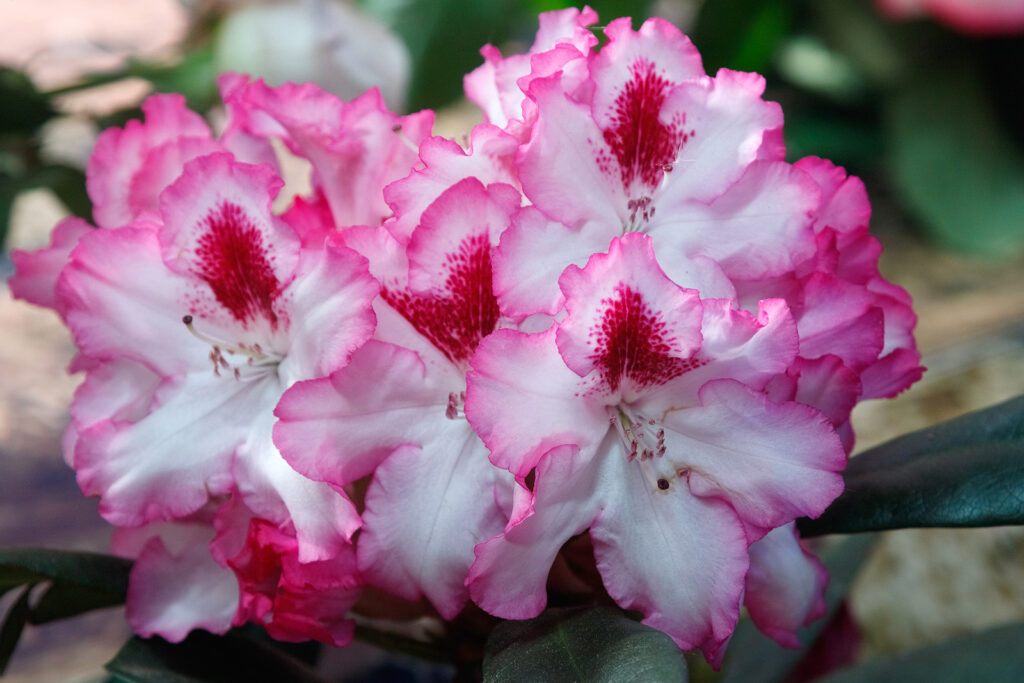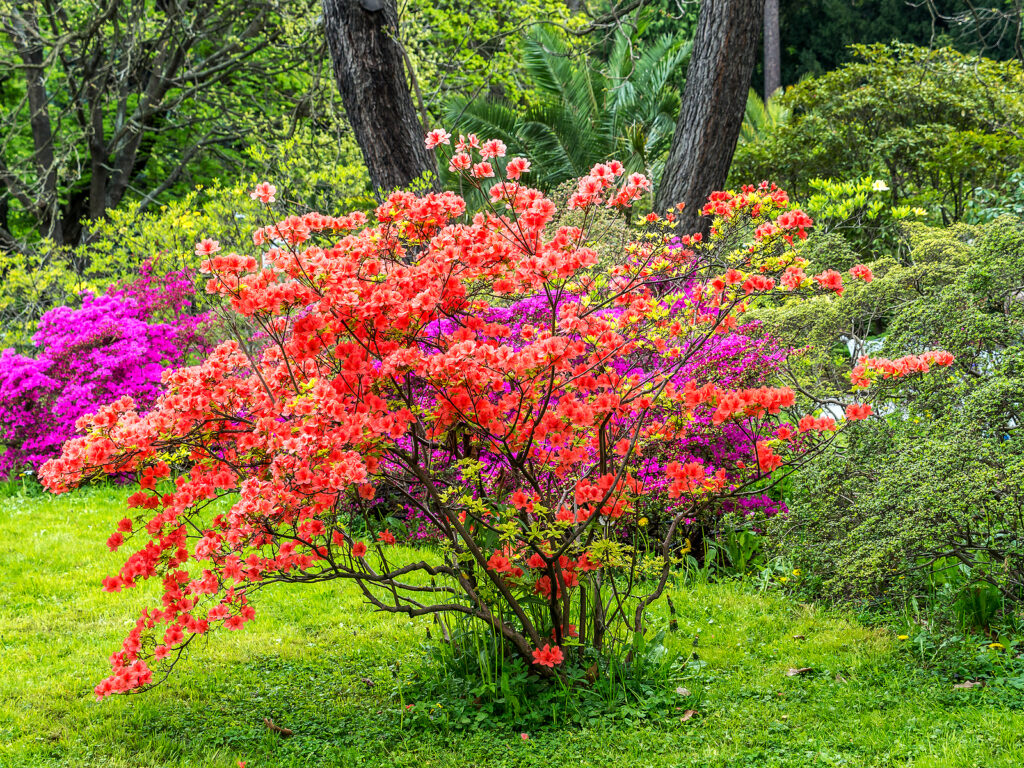Rhododendrons are grown primarily for their colorful flowers. Bloom colors include yellows and dark reds as well as pinks, purples, and whites. Blooms come in spring but also in midsummer and even fall depending on the variety.
The rhododendron genus contains more than 900 species of deciduous and evergreen shrubs and trees. There are more than 10,000 named varieties. Rhododendrons range from tree-size with large leaves to prostrate with very, very small leaves.
Rhododendrons grow best in a cool, moist climate with plenty of moisture in the atmosphere. They also need acid soil and soil moisture. This, of course, means they cannot be grown in all parts of the United States and many parts of the world where neither soil, climate nor moisture conditions are conducive to their good growth.
Botanically, azaleas are classified as rhododendrons. What’s the difference? Rhododendrons tend to be evergreen and have flowers shaped like bells, and azaleas tend to be deciduous and have funnel-shaped flowers. Azalea flowers have 5 stamens; rhododendron flowers have 10 or more stamens. That said, there are exceptions.
Azaleas are treated under a separate post on this website, but the growing requirements for rhododendrons and azaleas are essentially the same.

Get to Know Rhododendron
- Plant type: Evergreen or deciduous shrubs, some tree forms
- Growing zones and range: Zones 5 to 9 generally
- Hardiness: Cold tolerant; some are heat tolerant; seed Types below
- Height and width: Alpine creeping varieties can be 2 inches (5cm) tall; tall tree-size varieties can reach 100 feet (30cm); most rhododendrons are between 3 feet (.9m) and 8 feet (2.4m) tall.
- Foliage: Ovate, leathery leaves
- Flowers: Commonly bell-shaped flowers with 10 stamens; azaleas commonly have funnel-shaped flowers with 5 stamens; bloom colors include yellows and dark reds as well as pinks, purples, and whites.
- Bloom time: Spring, mid-summer, and autumn depending on the variety.
- Uses: Shrub borders, ground cover plants, specimens
- Companion plants: Plants that like the same conditions as rhododendrons but will not compete include primulas, lilies, meconopsis, gentians, trilliums, and erythroniums. Shrubs and smaller-leaved trees that are suitable include camellias, cornus, some maples, viburnums, and cotoneasters.
- Common name: Rhododendron
- Botanical name: Rhododendron
- Family name: Ericaceae
- Origin: Asia; about 30 species are native to North America
Where to Plant Rhododendrons
- Plant rhododendrons in dappled shade. Rhododendrons will grow in full sun where temperatures stay moderate in summer.
- Grow Rhododendron in humus-rich, well-drained soil.
- Rhododendrons grow best in loose, friable soil that the roots can easily penetrate.
- Add plenty of gritty sand and organic matter to clay soil before planting rhododendrons.
- Rhododendrons prefer acidic soil.
- Rhododendrons can not tolerate hot, dry, or windy conditions.
- As a general guideline, the larger the leaf the more shade and shelter from the wind the rhododendron needs.
When to Plant Rhododendrons
- Rhododendrons can be planted at any time, but spring and autumn are the times of the year when plants will be least stressed. Autumn planting allows roots to become established before spring growth begins.

Planting and Spacing Rhododendrons
- Set rhododendrons in a shallow planting hole; rhododendron have fine, surface-feeding roots so roots should not be set too deep.
- The rootball needs covering with no more than 1 to 2 inches (2.5cm) of soil. Planting too deeply can stunt plant growth.
- Space rhododendrons with mature height and width in mind. Allow some room between plants for air circulation which can decrease susceptibility to attack by pests and disease.
How to Water and Feed Rhododendrons
- Keep the soil evenly moist; avoid letting the soil dry out.
- Soak the soil well occasionally rather than watering little and often.
- Feed rhododendrons with aged compost; many rhododendrons, particularly small varieties, are intolerant of fertilizers and easily suffer leaf scorch.
Rhododendron Care
- Mulch around rhododendrons with pine needles or leaf mold; avoid cultivation which can disturb roots.
- Leaf mold and garden compost mulches provide nutrients that plants require.
- Keep the soil beneath and around rhododendrons free of weeds that compete for moisture and nutrients.
- Pruning rhododendrons is rarely necessary.
- Deadheading faded flower trusses bring on better new growth and more flower buds for the next season. When deadheading, be careful not to break off or damage the buds or young shoots just below the flowers.
- Pinch off spent flowers to avoid seed formation.
- Generally, the larger the leaf, the more protection the rhododendron needs from wind.
- Young plants are especially vulnerable to frost and cold; cover them on cold nights with frost cloth.
Pruning Rhododendrons
- Most rhododendrons need no pruning. Old and straggly specimens benefit from being cut back.
- Prune late-flowering plants in late winter or just after flowering.
- Carry out severe pruning in two or three stages, leaving some foliage each time. Remove the thick branches first, and if these put out new growth, cut back or remove thinner branches as you prune to form.
Growing Rhododendrons in Containers
- Grow rhododendrons in containers using acid, free-draining compost such as peat mixed with composted bark, good garden soil, leaf mold, or grit.
- Feed container growing rhododendrons with a slow-release fertilizer.
- Wrap the pot to protect the roots in cold weather and shade plants in hot weather or move to dappled shade.
- Repot plants into slightly larger containers every second year and give liquid or slow-release food in the growing season.
- Remove part of the roots of large plants every 2 to 3 years and put them back in the same pot with fresh compost added.
Rhododendron Pests and Diseases
- Rabbits and deer feed on azaleas and dwarf rhododendrons.
- Vine weevils, aphids, caterpillars, and slugs eat new leaves.
- Grey mold (botrytis) can afflict seedlings in autumn and winter.
- Powdery mildew can attack established plants.
- Honey fungus can attack and kill rhododendrons.
- Phytophthora, root rot, affects plants that have been kept too wet and too warm, especially plants growing in containers.
- Rust fungus can attack plants.

Rhododendron Propagation
- Propagate rhododendrons by planting tiny seeds under plastic and misting daily.
- Sow seed when the ripe capsule turns brown and start to split open. Sow seed in peat or sifted fresh sphagnum moss. Water from beneath.
- Sow seed outdoors in spring or sow seed indoors where heat and artificial light are available.
- Propagate rhododendron by layering. Help to layer by wounding the bark underneath. Keep the layer moist throughout the growing season. It takes a few years for an adequate root system to develop.
- Propagate rhododendrons by rooting semi-hardwood cuttings treated with hormone powder. Take cuttings from mid-summer onwards.
Types of Rhododendron
There are several thousand named rhododendron varieties and cultivars. Each of variety or cultivar falls into one of three groups—large leaf, small leaf, and Vireya. Here’s how these groups differ:
- Large-leaf evergreen rhododendrons: Members of this group vary from low, mounding to shrub and tree types. They have medium-sized to very large leaves. They bear flowers in a variety of shapes, sizes, and colors. This group includes the so-called ironclad hybrids. Ironclad hybrids for coldest winters can take temperatures as low as -25°F (-32°C), included are ‘America’, ‘Boule de Neige’, ‘English Roseum’, ‘Nova Zembla’, ‘Parsons Gloriosum’, ‘President Lincoln’, ‘Roseum Elegans.’ Also, ironclad hybrids that tolerate hot summers which include ‘Anah Kruschke’, ‘Belle Heller’, ‘Cheer’, ‘Cynthia’, ‘Fastosum Flore Pleno’, ‘Holden’, ‘Scintillation’.
- Small-leaf evergreen rhododendrons: Members of this group vary from almost prostrate spreaders and dwarf cushions to tall shrubs. Leaf-size varies from very small to medium-sized and flower colors include the full spectrum except for red. This group includes various hardy plants.
- Vireya rhododendrons: Members of this group are native to the tropics of Southeast Asia. Members of this group grow in frostless zones. They can be grown in containers in colder zones and brought indoors in winter. These rhododendrons flower off and on throughout the year in shades of yellow, gold, orange, vermillion, salmon, pink, cream, white, and bi-colors.
To choose a rhododendron for your garden, visit a nearby garden center. They will stock or order plants suitable for your climate.
Azaleas are not included here. See How to Grow Azaleas.















